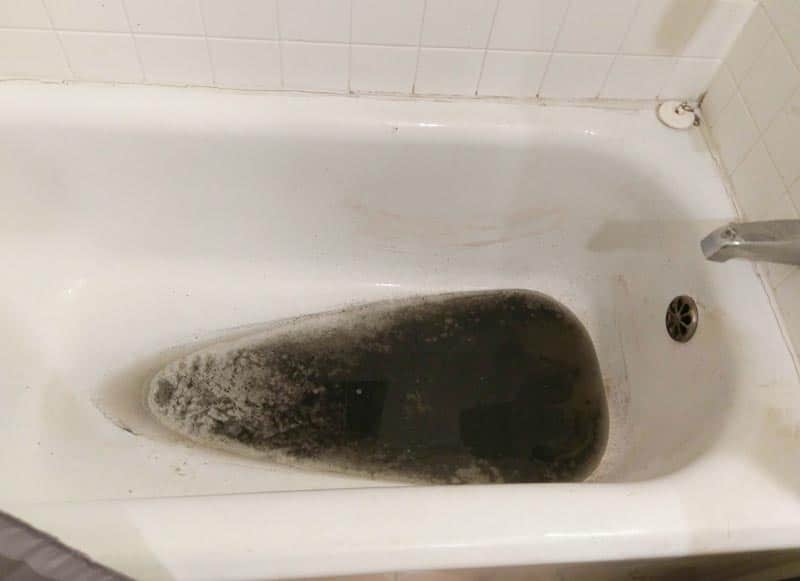Significant Explanations for Discharge in the Bathtub
Significant Explanations for Discharge in the Bathtub
Blog Article
How do you really feel when it comes to What to Do if Sewage Starts Coming Up Through Your Bathtub?

Sewer back-up in the bathtub can be an upsetting and unsanitary trouble for any type of home owner. Not only is it troublesome, yet it likewise poses major health and wellness risks and shows underlying issues with the plumbing system. Recognizing why sewer is coming up via the bathtub is vital for taking proper activity to deal with the problem successfully.
Introduction to the Issue
Common Factors for Sewer Backup
Clogs in the Sewage System Line
Among the most typical root causes of sewage backup is a clog in the sewer line. This can take place as a result of the buildup of debris, grease, or foreign things in the pipes, protecting against correct circulation and creating sewer to back up right into your bath tub.
Tree Root Breach
Tree origins seeking dampness and nutrients can penetrate drain lines with small cracks or joints. Gradually, these roots can grow and expand, causing substantial damages to the pipelines and causing sewer backup concerns.
Recognizing the Trouble
When sewer draws back up into the bath tub, it's a clear indicator of an issue with the drainage system. The wastewater that should be moving away from your home is rather locating its back right into your home, which can bring about considerable damage and carcinogen.
Prospective Reasons
A number of aspects can contribute to sewer back-up in the tub. From clogs in the sewer line to problems with the plumbing facilities, determining the root cause is important for discovering a solution.
Aging Framework
Older homes might have obsoleted plumbing systems that are extra susceptible to corrosion, splits, and damage. As pipes age, they come to be a lot more susceptible to leakages and clogs, increasing the possibility of sewer back-up cases.
Heavy Rainfall or Flooding
During durations of heavy rainfall or flooding, the drain system may become overloaded with excess water, triggering backups and overflows. This can result in sewer backing up into bathtubs and various other fixtures inside the home.
Signs of Sewer Back-up
Foul Odors
Undesirable smells originating from drains or components, particularly in the washroom, may indicate sewage back-up problems. These smells are often solid and relentless, signifying a trouble that calls for immediate attention.
Slow Draining Fixtures
Tubs, sinks, and toilets that drain pipes slowly or not in all could be experiencing sewage backup. If numerous components are affected all at once, it's most likely that the concern originates from a common point, such as the major sewer line.
Gurgling Sounds
Unusual gurgling or gurgling noises originating from drains when water is running in other places in the house are indicative of air caught in the plumbing system. This air accumulation can result from sewer back-up and must be explored immediately.
Health Dangers Connected With Sewer Backup
Contamination of Water System
Sewer back-up can pollute the supply of water in your home, presenting a severe wellness risk to you and your family. Direct exposure to infected water can cause gastrointestinal problems, skin infections, and various other illnesses.
Mold and mildew Growth
Wetness from sewer back-up can create perfect problems for mold and mildew growth in your house. Mold spores can exacerbate respiratory troubles and trigger allergic reactions in sensitive people, making punctual cleanup vital.
Spread of Disease
Sewage consists of hazardous bacteria, viruses, and parasites that can trigger a variety of illness, consisting of hepatitis, cholera, and gastroenteritis. Coming into contact with sewer or polluted surfaces places you at risk of infection.
Tidying up After Sewage Backup
Disinfection Procedures
Extensively disinfect and sterilize influenced areas after sewer back-up to get rid of dangerous germs and avoid mold and mildew development. Usage appropriate cleansing items and protective equipment to guarantee secure and effective clean-up.
Remediation of Influenced Areas
Fix any kind of damage to floor covering, walls, or components brought on by sewer backup. Relying on the degree of the damages, you might require to replace carpeting, drywall, or various other materials to recover your home to its pre-loss condition.
Immediate Actions to Take
Shutting Off Supply Of Water
In case of sewage backup, it's vital to switch off the water to prevent more contamination and damage. Locate the main water shutoff valve in your house and shut it off up until the concern can be settled.
Calling an Expert Plumber
Taking care of sewer back-up is not a do it yourself job. Contact an accredited plumber with experience in managing sewage-related issues to examine the situation and perform essential repair work or cleanings.
Staying Clear Of Contact with Contaminated Water
Until the sewage backup is settled, stay clear of contact with contaminated water to stop the spread of bacteria and pathogens. Wear protective gear if you must remain in the affected area and wash your hands extensively afterward.
Safety nets
Regular Upkeep of Sewage System Lines
Set up routine evaluations and upkeep of your drain lines to recognize and resolve possible issues prior to they intensify into significant issues. This can include cleaning out debris, checking for tree root breach, and fixing any kind of damaged pipes.
Mounting Bayou Shutoffs
Consider installing backwater valves in your plumbing system to avoid sewage from receding right into your home during periods of heavy rainfall or flooding. These shutoffs instantly close when water draws back up, shielding your building from contamination.
Appropriate Disposal of Family Waste
Prevent flushing anything aside from toilet paper and human waste down the toilet to avoid clogs and blockages in the drain line. Dispose of oil, oil, and various other house chemicals appropriately to reduce the risk of plumbing troubles.
Why Is Water Backing Up in My Bathtub When I Flush My Toilet?
What to do about a sewer line clog
First, don’t bother with plunging. No amount of plunging will dislodge the clog in a sewer line. The clog is too far away. Plungers are for clogs in the toilet itself, not the sewer line. Plus, the most likely causes of a sewer clog are:
Tree roots Flushed toys or feminine products Grease buildup Those items don’t move easily. And in the case of tree roots, the roots need to be cut out of the pipe and the pipe will need to be repaired.
You’ll need a closet auger. A closet auger is a type of plumber’s snake with a protective cover to keep from scratching the delicate porcelain toilet. If the clog is further down, you may need to remove the toilet or use one of your cleanouts to get to the clog.
We also recommend doing a video inspection of the drain to ensure that the cause of the clog has been completely removed. Otherwise, you could have the same problem again in a few days or weeks.
https://mspplumbingheatingair.com/blog/why-is-water-backing-up-in-my-bathtub-when-i-flush-my-toilet

I hope you liked our excerpt about Water Coming up Bathtub Drain. Thank you so much for taking a few minutes to browse our blog. Sharing is good. Helping others is fun. I recognize the value of your readership.
Click Here
Report this page